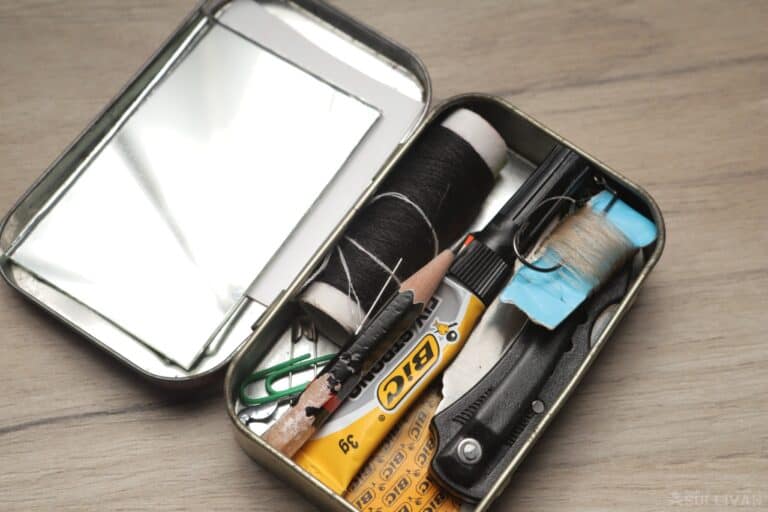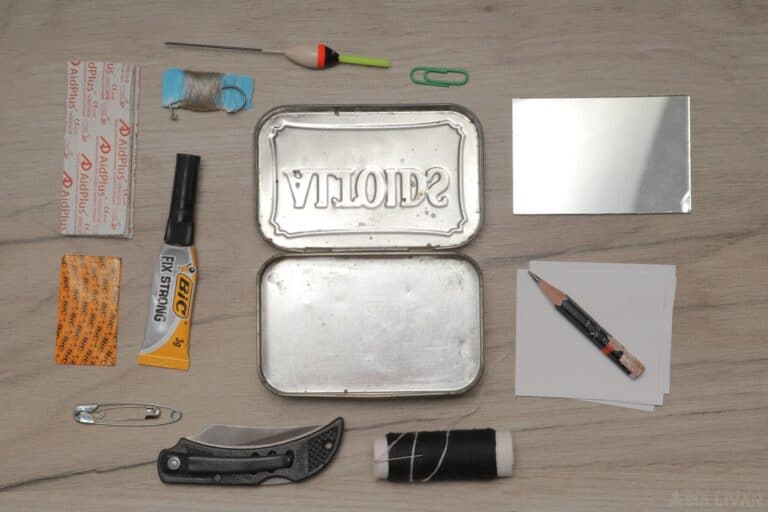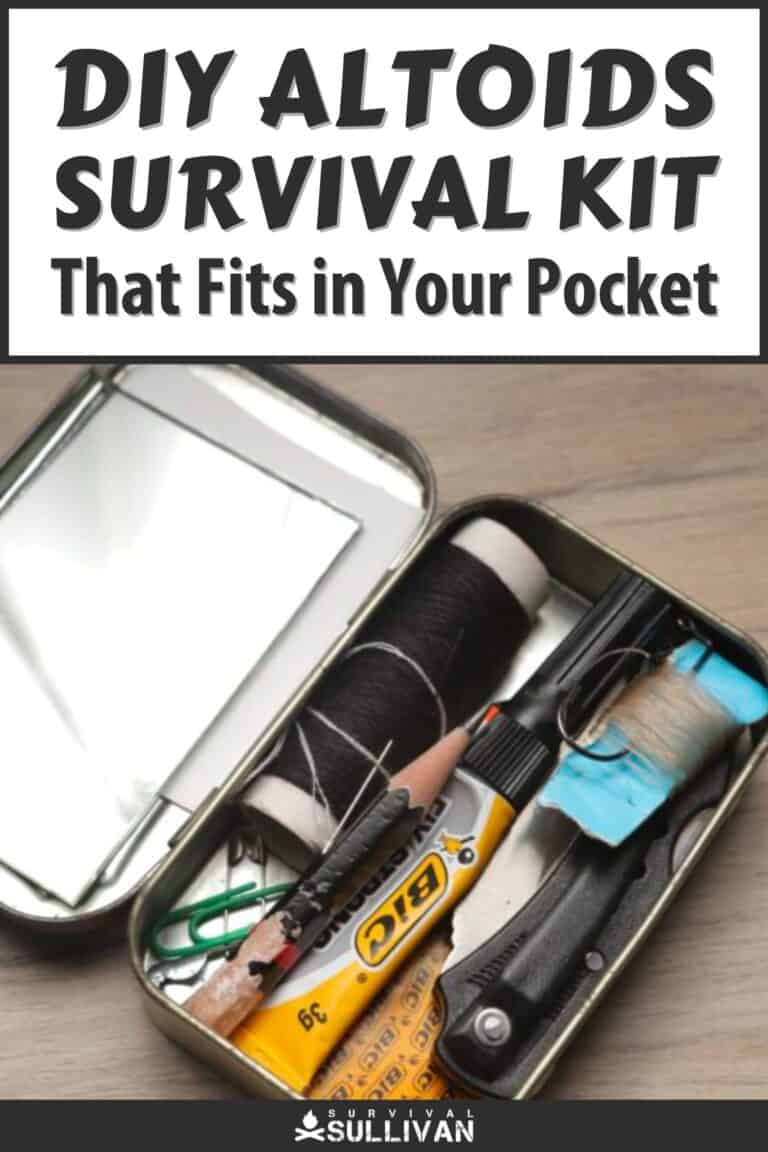[ad_1]
A big part of prepping and personal preparedness is assessing your own risk factors and acting accordingly. In fact, you might say that one of the graduating exercises for becoming a true adherent on the path of readiness is assembling your own survival kits.

One of my favorite exercises and also my favorite pieces of gear is the time-honored Altoids tin survival kit.
These tiny tins are charming, sure, but they are also practical containers that are surprisingly durable and they can hold a lot of gear as long as it’s miniature in size.
Best of all, they are small enough to go with you absolutely everywhere and that makes them especially valuable.
Today I’ll be taking you through this prepping rite of passage and telling you the why as well as the how behind packing your own DIY Altoids survival kit.
Why an Altoids Tin in the First Place?
I want to address a question that many readers are probably asking themselves right now. Why on Earth would you use an Altoids tin for this? Why not choose a tiny Pelican case, a DAKA bag, or anything else that’s more durable and more practical?
Altoids tins are surprisingly durable and practical. Then there’s the fact that reusing and recycling sharpens a person’s improvisational and lateral thinking skills, both useful attributes in a survival scenario.
And then, there is the sheer and hard-to-define pleasure of packing so much capability into such a tiny space, and doing it ourselves!
But enough about the why. Time to get to the nitty-gritty.

Items to Include in Your Altoids Tin Survival Kit
1. Signal Mirror
A signal mirror can be a critical tool in a survival situation, as it allows you to reflect sunlight toward someone who can help you or signal your location to search and rescue teams.
A signal mirror typically consists of a small mirror made of glass or metal that has a sighting device to help you aim the reflection.
When it comes to creating a compact and portable survival kit like an Altoids tin survival kit, a signal mirror is an ideal addition due to its small size, flatness, and overall effectiveness.
You’ll need to use the sighting device to ensure that you’re accurately aiming the reflection where it needs to go. Practice with this before you need it!
2. Compass
Every survivor and outdoorsman knows the value of a compass. You’ll want one in your survival kit for obvious reasons, but for our tiny Altoids tin kit only the smallest will do.
Luckily, there are several high-quality, tiny compasses on the market, usually referred to as button compasses.
They are small enough to rest easily on a fingertip and, again, take up little no space in a tiny tin like this.
Make sure your compass is working properly before you put it into your kit and also learn some land nav basics so that you can trust it when you need it.
Also remember that compasses work best in an open area away from electrical interference and metal, like our tin container, here!
3. Ferro Rod and Striker
Another quintessential tool in the wilderness, a Ferro rod and striker will help you make fire when other methods of ignition aren’t available or not practical.
It’s effective, reusable hundreds or thousands of times, and functional even after getting wet.
These come in a variety of sizes, but for our purpose here look for the smallest ones that still have a usable surface area for striking sparks, or “retire” a larger rod to this kit once it gets whittled down to an appropriate size.
Make sure it comes with an accompanying striker so you always have the components you need at hand with this kit alone.
4. Storm Matches
Ferro rods are great, but sometimes you need a swifter and less dexterity-intensive method of getting a fire going.
Storm matches are a great option for this, as they are designed never to be completely waterproof and to never go out in wind and rain once struck.
As you can imagine, these are incredibly handy in emergencies and you’ll want to keep some on hand at all times.
Fire is essential for many reasons – boiling water, cooking food, providing warmth, and signaling your location – so that’s why we include multiple pieces of firestarting gear.
Depending on your matches, they might be “strike anywhere” or they might need a striker strip to activate, usually on or in the container they are sold with. You can repurpose this striker by taping it inside the tin. Done!
5. Tinder Ball
Having the tools to create a flame is just one part of the survival equation. The other is actually building, sustaining and maintaining a fire.
To help you accomplish that, you will need tinder. Tinder is anything small and highly flammable that you can use to catch your spark or flame and start a fire by igniting larger fuel in the form of kindling.
For our purposes, DIY options are again best. Several small items can suffice as super compact and compressible tinder, such as dryer lint, rubber stripes, or even Vaseline-coated cotton balls.
Any will do the trick, and all are super light and compact. If you use the old Vaseline-soaked cotton trick, make sure you wrap them in a plastic baggie to keep them from making a mess and also to keep them moist.
6. Band-Aids
If you are in a survival situation, you’re probably already injured, or else will soon be injured, no matter how careful you are.
Even minor injuries can take on life-threatening proportions if not addressed properly and quickly due to the risk of infection.
That’s why you should always include a few band-aids in your kit, just in case. They take up almost no space and can be helpful for minor cuts and scrapes or even blisters.
Obviously, these are not going to even help with serious wounds, but this is part of the limitations of our tiny kit: it simply cannot hold larger and more substantial first-aid supplies.
7. Butterfly Closures
Another super small first-aid item that may, in fact, help deal with a serious slice. Butterfly closures are great for closing up deeper cuts in a pinch where stitches may not be an option. They can reduce the risk of infection until professional medical help can be reached.
These tiny items take up almost no space but could make a huge difference if you find yourself needing to stop some major leaking.
8. Antiseptic Wipe
As mentioned above, infection is the number one concern when injured in any legitimate survival scenario, at least one where proper medical care is a long way off or totally unavailable. To help combat this risk you should keep at least one antiseptic wipe handy in your kit.
These can be used to clean any open wounds and reduce the risk of infection. The best part is that these take up almost no space so you will still have plenty of room for other gear in the tin.
As far as to which type or formula you should use, pick your favorite. Alcohol works well but hurts like hell, and you should keep in mind you might be using these pads on yourself!
9. Sting Relief Pad
Bites and stings from all of the insectoid denizens of the wild will rarely prove fatal, but they can seriously dampen your morale and your will. This is why you should have a sting relief pad in your kit…
These are small and effective for quickly killing the pain from a bug bite or bee sting without taking up too much space in the tin.
They can help keep you a little comfortable during tough times so that you can stay focused on your survival objectives.
Again, this is also a great inclusion for the sake of kids and others who you might be responsible for. I remember when I was a kid, a wasp sting felt like a fatal wound!
10. Pain Reliever
Out in the world, in a survival situation, everything is going to hurt. You can help keep your mind right and efficiency high by keeping a dose or two of pain relievers in your Altoids kit.
Depending on the size of the tin, you might only be able to fit a single dose pouch of ibuprofen, acetaminophen, or aspirin, perhaps two.
Again, it’s a compromise, but it might prove to be enough in shorter scenarios or until a natural supplement can be found and implemented.
11. Nausea/Diarrhea Meds
Included for the same reason as above. Sheer nerves, to say nothing of unusual food and dodgy water is going to play hell on your digestive system.
Include a pack of powdered anti-diarrhea meds and maybe some anti-nausea medication too if you have the space in your kit, just in case this is something you need to address on the fly in an emergency.
This isn’t just for comfort and civility, either: Diarrhea will rapidly strip your body of crucial moisture and electrolytes when you can least afford to lose them, so squashing the problem is paramount when the chips are down!
12. Moleskin
Your feet will be the only transportation you can truly trust at the end of the day, and that means keeping them functional is critical.
Enemy Number One to that end is a blister. A bad blister can cripple, and also easily get infected. The solution is to nip it in the bud before it gets out of hand (or rather foot) by using moleskin.
Moleskin is easily cut to size and can help fight friction and blisters so that you can continue your mission with minimal pain or interference.
A small piece of this addition to the Altoids tin can save a great deal of suffering down the line, and it easily nestles into the bottom of the tin or the top of the lid.
13. Superglue
Superglue is super-useful, both for repairing needed gear or stopping leaks, and also for first-aid use, acting as a liquid stitch.
This is especially helpful if you got cut on a jagged piece of metal or glass and need to close an irregular wound that is tough to bandage or stitch any other way. Superglue is not ideal, but in an emergency situation, it can be a lifesaver.
Several brands sell the itty bitty “single use” vials that are picture-perfect for our kit, here.
14. Razor Blade / X-acto Blade
Having a good blade at your side is one of the fundamental rules of being prepared. Ideally, you will have a sturdy folder in your pocket along with this kit or even a beefy fixed blade strapped on.
But if you don’t you will at least have something if you toss in a small “window scraper” razor blade or X-acto knife.
They might be tiny, but these wickedly sharp and strong blades are great for cutting through strapping, cordage, small branches, and so on.
Either is also helpful for whittling points on arrows or spears to hunt with if needed, and countless other small scale survival tasks.
15. Steri-Tabs
Water is another critical survival priority and one you must secure at once unless you have access to a large supply.
But water must be treated to make it safe unless you want to get gravely sick. We don’t have room in our kit for a proper water filter, but we do have space for some steri-tabs, which will kill anything bad in it.
One dose can treat quite a bit of lake water or snow melt and make it potable, so stash a couple in your Altoids tin to help stay hydrated safely.
16. Sewing Kit
Another seemingly curious inclusion in our curiously strong tin, but a sewing kit offers great multi-purpose capability if you have the skills.
You can use a kit to patch holes in garments, repair gear, and even stitch wounds if needed. It can also help you craft shelter from leaves or found materials.
This one is a no-brainer: everyone should have some basic sewing skills and supplies ready at hand. It’s not the most glamorous item in our tin, but it could help save the day…
Some thread or paracord guts, a handful of needles, and a couple of buttons can easily fit in your kit and be invaluable when you need it most.
17. Safety Pins
Safety pins are not redundant to the sewing kit above, though they do accompany it. Safety pins are among my favorite repurposed survival materials.
They can be used for attaching items to the outside of your pack, repairing clothing, holding bandages and dressings in place, and even as makeshift fishhooks or tines on a small game gig or spear. These thin but strong pins can really do a lot in an emergency situation.
18. Snare Wire
Trapping small game is a great way to supplement your food supply. Snare wire is incredibly thin, so it can be wound up into a tiny bundle and fit snugly in our kit.
You can use a few feet of snare wire to set up several snares along trails or other places in the woods where small critters like rabbits and squirrels tend to move.
Snare wire is also great for lashing together materials when a rope or cordage isn’t available, such as binding up your shelter tarp, and works great as a tripwire for other purposes. Too small and too good to not have!
19. Fishing Gear
You knew a fishing kit was going to be on here at some point, and you already know why it is useful.
A few hooks, some line, lead weights, cork strips for bobbers – all these things are great to have on hand in our kit when we’re out in the wild.
It doesn’t take much to make a respectable fishing rig, and you don’t need bulky lures or fancy reels either. Just enough to catch something for lunch.
20. Tiny Notebook and Golf Pencil or Pen
One of my personal favorite inclusions. The power of a pad and pen cannot be underestimated.
From sketching out your own survival map or leaving a note for others who might follow, a little paper can make a difference.
I like the tiny Rite-in-the-Rain notebooks the most since they are waterproof. Include a compact pen or golf pencil of your choice.
21. Mini Swiss Army Knife
If you can make it fit, a fully functional, sharp Swiss army knife will provide you with several useful tools and a wickedly sharp knife in a small package.
Optional if you don’t have room or habitually carry one in your pocket.
22. Rigger Bands / Inner Tube
The very last thing. Use some rigger bands, heavy-duty rubber bands, or bicycle inner tube slices to hold your kit closed.
If our nifty tin here has one weakness it is that it is highly prone to popping open at inopportune times, especially when packed tightly.
An easy solution is to just use hefty elastic bands to hold it closed, and they can also serve as another useful item, be it for tinder or lashing.
Don’t Be Afraid to Modify These Contents
Remember what I said way back in the beginning of this article? You shouldn’t be afraid to make changes to this kit to better suit your own needs.
Maybe you need more fire-starting gear as insurance in cold climates. Or perhaps you find that an item already included is redundant, so take it out and replace it with something else useful.
Maybe you want to lean more into first-aid supplies and omit the fishing kit. You should!
Trust your own good sense, but all the same, I hope this article showed you the utility of the classic Altoids tin survival kit and inspired you to assemble your own.

[ad_2]
Source link
Get more stuff like this
in your inbox
Don't Be Left Unprepared
Thank you for subscribing.
Something went wrong.



